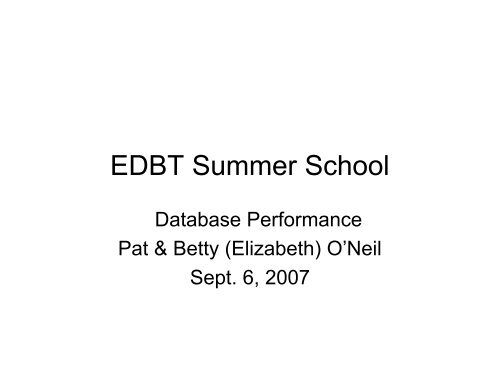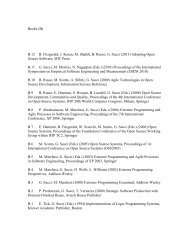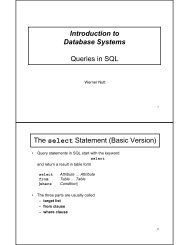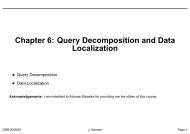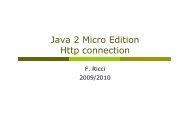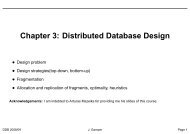Create successful ePaper yourself
Turn your PDF publications into a flip-book with our unique Google optimized e-Paper software.
EDBT Summer School<br />
Database Performance<br />
Pat & Betty (Elizabeth) O’Neil<br />
Sept. 6, 2007
Database Performance: Outline<br />
<br />
<br />
<br />
<br />
<br />
<br />
Here is an outline of our two-lecture course<br />
First, we explain why OLTP performance is no longer thought to<br />
be an important problem by most researchers and developers<br />
But we’ll introduce a new popular Transactional product called<br />
Snapshot Isolation that supports updates & concurrent queries<br />
Then we look at queries, especially Data Warehouse queries,<br />
which get the most performance attention currently<br />
We explain early query performance concepts, e.g. index Filter<br />
Factor, then look at cubical clustering, the new crucial factor<br />
Data Warehousing is where most new purchases are made at<br />
present, and we examine the area in detail<br />
2
DB Performance: OLTP<br />
Jim Gray said years ago: OLTP is a solved problem<br />
Older established companies that do OLTP Order Entry have<br />
solutions in place, efficient enough not to need change<br />
One reason is that change is very difficult: rewriting a company’s<br />
OLTP programs is called the “Dusty Decks” problem<br />
Nobody remembers how all the code works!<br />
Also, the cost of hardware to support update transactions<br />
compared to programming costs, or even terminal costs, is low<br />
We explain this in the <strong>slides</strong> immediately following<br />
But some new installations use new transactional approaches<br />
that better support queries, such as Snapshot Isolation<br />
We explain Snapshot Isolation a bit later (starting on Slide 7)<br />
3
OLTP DebitCredit Benchmark<br />
Anon [Jim Gray] et al. paper (in Datamation, 1985)<br />
introduced the DebitCredit benchmark.<br />
Bank Transaction tables: Acct, Teller, Brnch, History, with 100 byte rows<br />
Read 100 bytes from terminal: aid, tid, bid, delta<br />
Begin Transaction;<br />
Update Accnt set Accnt_bal = Accnt_bal +:delta where Accnt_ID = :aid;<br />
Insert to History values (:aid,:tid, :bid, :delta, Time_stamp);<br />
Update Teller set Teller_bal = Teller_bal + :delta where Teller_ID = :tid;<br />
Update Brnch set Brnch_bal = Brnch_bal+:delta where Brnch_ID = :bid;<br />
Commit;<br />
Write 200 bytes to terminal including: aid, tid, bid, delta, Accnt_bal<br />
Transactions per second (tps) scaled with size of tables: each tps had<br />
100,000 Accnts, 10 Brnches, 100 Tellers; History held 90 days of inserts<br />
1 History of DebitCredit/TPC-A in Jim Gray’s “The Benchmark Handbook”, Chapter 2.<br />
4
OLTP DebitCredit Benchmark<br />
<br />
<br />
<br />
<br />
<br />
<br />
<br />
DebitCredit restrictions; performance features tested<br />
Terminal request response time required 95% under 1 second;<br />
throughput driver had to be titrated to give needed response<br />
Think time was 100 secs (after response): meant much context<br />
had to be held in memory for terminals (10,000 for 100 tps)<br />
Terminal simulators were used; Variant TP1 benchmark drove<br />
transactions by software loop generation with trivial think time<br />
Mirrored Tx logs required to provide guaranteed recovery<br />
History Inserts (50 byte rows) costly if pages locked<br />
System had to be priced, measured in $/tps<br />
5
OLTP DebitCredit/TPC-A Benchmark<br />
<br />
<br />
<br />
<br />
Vendors cheated when running DebitCredit<br />
Jim Gray welcomed new Transaction Processing Performance<br />
Council (TPC), consortium of vendors, created TPC-A 1 in 1989<br />
Change from DebitCredit: measurement rules were carefully<br />
specified and auditors were required for results to be published<br />
Detail changes:<br />
For each 1 tps, only one Branch instead of 10: meant concurrency<br />
would be tougher: important to update Branch LAST<br />
Instead of 100 sec Think Time, used 10 sec. Unrealistic, but reason<br />
was that TERMINAL PRICES WERE TOO HIGH WITH 100 SEC!<br />
Terminal prices were more than all other costs for benchmark<br />
Even in 1989, transactions were cheap to run!<br />
1 History of DebitCredit/TPC-A in Jim Gray’s “The Benchmark Handbook”, Chapter 2. In ACM<br />
SIGMOD Anthology, http://www.sigmod.org/dblp/db/books/collections/gray93.html<br />
6
DB Performance: OLTP & Queries<br />
<br />
<br />
<br />
<br />
<br />
<br />
Amazon doesn’t use OLTP of any DBMS to enter purchases in<br />
a customer’s shopping cart (does for dollar transactions though)<br />
Each purchase is saved using a PC file system, with mirroring &<br />
replication for failover in case of node drop-out: log not needed<br />
Classical OLTP not needed because only one purchase saved<br />
at a time on a single-user shopping cart<br />
There is one new approach to transactional isolation adopted for<br />
some new applications, mainly used to support faster queries<br />
It is called “Snapshot Isolation” 1 (SI), and it has been adopted in<br />
both the Oracle and Microsoft SQL Server database products<br />
SI is not fully Serializable, so it is officially an Isolation Level, but<br />
anomalies are rare and Queries aren’t blocked by Update Tx’s<br />
1 First published in SIGMOD 2005. A Critique of ANSI Isolation Levels. by Hal Berenson, Phil<br />
Bernstein, Jim Gray, Jim Melton, Pat O’Neil and Elizabeth O’Neil<br />
7
DB Performance: Snapshot Isolation (SI)<br />
<br />
<br />
<br />
<br />
<br />
<br />
A transaction T i executing under Snapshot Isolation (SI) reads<br />
only committed data as of the time Start(T i )<br />
This doesn’t work by taking a “snapshot” of all data when new<br />
Tx starts, but by taking a timestamp and keeping old versions of<br />
data when new versions are written: Histories in SI read & write<br />
“versions” of data items<br />
Data read, including both row values and indexes, time travels<br />
to Start(T i ), so predicates read by T i also time travel to Start(T i )<br />
A transaction T i in SI also maintains data it has written in a local<br />
cache, so if it rereads this data, it will read what it wrote<br />
No T k concurrent with T i (overlapping lifetimes) can read what T i<br />
has written (can only read data committed as of Start(T k ))<br />
If concurrent transactions both update same data item A, then<br />
second one trying to commit will abort (First committer wins rule)<br />
8
DB Performance: Snapshot Isolation (SI)<br />
<br />
<br />
<br />
<br />
<br />
<br />
SI Histories read and write Versions of data items: (X0, X1, X2);<br />
X0 is value before updates, X2 would be written by T 2 , X7 by T 7<br />
Standard Tx’l anomalies of non-SR behavior don’t occur in SI<br />
Lost Update anomaly in Isolation Level READ COMMITTED<br />
(READ COMMITTED is Default Isolation Level on all DB products) :<br />
(I’m underlining T 2 ’s operations just to group them visually)<br />
H1: R 1 (X,50) R 2 (X,50) W 2 (X,70) C 2 W 1 (X,60) C 1 (X should be 80)<br />
In SI, First Committer Wins property prevents this anomaly:<br />
H1 SI : R 1 (X0,50) R 2 (X0,50) W 2 (X2,70) C 2 W 1 (X1,60) A 1<br />
Inconsistent View anomaly possible in READ COMMITTED:<br />
H2: R 1 (X,50) R 2 (X,50) W 2 (X,70) R 2 (Y,50) W 2 (Y,30) C 2 R 1 (Y,30) C 1<br />
Here T1 sees X+Y = 80; In SI, Snapshot Read avoids this anomaly<br />
H2 SI : R 1 (X0,50) R 2 (X0,50) W 2 (X2,70) R 2 (Y0,50) W 2 (Y2,30) C 2<br />
R 1 (Y0,50) C 1 (T 1 reads sum of X+Y = 100, valid at Start(T 1 )<br />
9
DB Performance: Snapshot Isolation<br />
In SI, READ-ONLY T 1 never has to wait for Update T 2<br />
since T 1 reads consistent committed data at Start(T 1 )<br />
Customers LIKE this property!<br />
SI was adopted by Oracle to avoid implementing DB2<br />
Key Value Locking that prevents predicate anomalies<br />
In SI, new row insert by T 2 into predicate read by T 1<br />
won’t be accessed by T 1 (since index entries have<br />
versions as well)<br />
Customers using Oracle asked Microsoft to adopt SI<br />
as well, so Readers wouldn’t have to WAIT<br />
10
DB Performance: Snapshot Isolation<br />
<br />
<br />
<br />
<br />
<br />
Oracle calls the SI Isolation Level “SERIALIZABLE”<br />
SI is not truly SERIALIZABLE (SR); anomalies exist<br />
Assume husband and wife have bank account balances A and B<br />
with starting values 100; Bank allows withdrawals from these<br />
accounts to bring balances A or B negative as long as A+B > 0<br />
This is a weird constraint; banks probably wouldn’t impose it<br />
In SI can see following history:<br />
H3: R 1 (A0,100) R 1 (B0,100) R 2 (A0,100) R 2 (B0,100) W 2 (A2,-30) C 2<br />
W 1 (B1,-30) C 1<br />
Both T 1 and T 2 expect total balance will end positive, but it goes<br />
negative because each Tx has value it read changed by other Tx<br />
This is called a “Skew Writes” anomaly: weird constraint fails<br />
11
Snapshot Isolation Skew-Write Anomaly<br />
R 1 (A0,100) R 1 (B0,100) R 2 (A0,100) R 2 (B0,100) W 2 (A2,-30) C 2 W 1 (B1,-30) C 1<br />
R 1 (A0,100) R 1 (B0,100)<br />
T1<br />
W 1 (B1,-30) C 1<br />
T2<br />
Conflict cycle<br />
allowed by SI<br />
R 2 (A0,100) R 2 (B0,100) W 2 (A2,-30) C 2<br />
Time-->
DB Performance: Snapshot Isolation<br />
<br />
<br />
Here is a Skew Write anomaly with no pre-existing constraint<br />
Assume T 1 copies data item X to Y and T 2 copies Y to X<br />
R 1 (X0,10) R 2 (Y0,20) W 1 (Y1,10) C 1 W 2 (X2,20) C 2<br />
Concurrent T 1 & T 2 only exchange values of X and Y<br />
<br />
<br />
But any serial execution of T 1 & T 2 would end with X and Y<br />
identical, so this history is not SR<br />
Once again we see an example of skew writes: each concurrent<br />
Tx depends on value that gets changed<br />
The rule (constraint?) broken is quite odd, and unavoidable: it is<br />
one that comes into existence only as a post-condition!<br />
13
DB Performance: Snapshot Isolation<br />
<br />
<br />
<br />
<br />
<br />
SI anomalies rarely occur in commercial applications<br />
Oracle called SI “SERIALIZABLE” when they learned it had no<br />
anomalies in the (Tx’l) TPC-C benchmark<br />
It is also usually possible to prevent SI anomalies with proper<br />
forethought 1 : here is Skew Write anomaly<br />
R 1 (X0,10) R 2 (Y0,20) W 1 (Y1,10) C 1 W 2 (X2,20) C 2<br />
Can “Select For Update” Oracle, like Writing same value so<br />
Crucial read is stable (symbolize below with RU)<br />
RU 1 (X0,10) RU 2 (Y0,20) W 1 (Y1,10) C 1 W 2 (X2,20) A 2<br />
SI shows there is transactional research possible, but ANTS<br />
product writeup 1 seems to push OLTP performance to its limit!<br />
1 For details see: A. Fekete, D. Liarokapis, E. O’Neil, P. O’Neil and D. Shasha.<br />
Making Snapshot Isolation Serializable. ACM TODS, Vol 30, No. 2, June 2005<br />
2 Download from http://www.cs.umb.edu/~poneil/ANTS.pdf<br />
14
DB Performance: Queries<br />
Companies are spending the most money now on<br />
developing query systems, with few, if any, updates<br />
I’ll start with some historical development<br />
E. F. Codd’s Relational Paper was published in 1970;<br />
Codd worked at IBM; DB2 was first released in 1982<br />
SEQUEL, early SQL, was published 1 in 1974 for<br />
use in IBM’s System R, a DB2 precursor<br />
ORACLE (then Relational Software, Inc.) put out a<br />
commercial version of SQL in 1979<br />
1<br />
Donald Chamberlin and Raymond Boyce, 1974. SEQUEL: A Structured English Query<br />
Language. SIGFIDET (later SIGMOD), pp. 249-264.<br />
15
DB Performance: Early DB2 & M204<br />
DB2 Query Indexes were explained in 1979 paper 1<br />
<br />
<br />
<br />
<br />
Rather primitive: Choose single column restriction that gives<br />
smallest “selectivity factor” F<br />
Selectivity factor was later “Filter Factor” in documentation<br />
The ability to AND Filter Factors waited until DB2 V2, 1988<br />
After DB2 was introduced, Pat was working at CCA, which sold<br />
a DBMS called Model 204 (M204) with efficient bitmap indexing<br />
Pat published a paper called “The Set Query Benchmark” 2 that<br />
compared M204 query performance to that of DB2 on MVS<br />
Lucky that DB2 allowed this: DBMS products today would sue<br />
1 P.G. Selinger et al., Access Path Selection in a relational database management system.<br />
SIGMOD 1979; 2 P. O'Neil. The Set Query Benchmark. Chapter 6 in The Benchmark Handbook for<br />
Database and Transaction Processing Systems. (1st Edition, 1989, 2nd Ed., 1993)<br />
16
DB Performance: Set Query Benchmark<br />
<br />
<br />
<br />
<br />
<br />
<br />
<br />
Set Query Benchmark (SQB) has one table: BENCH (we tested<br />
table join performance using self-joins on single BENCH table)<br />
BENCH table has 1,000,000 200-byte rows with a clustering<br />
column KSEQ having sequential values 1, 2, . . ., 1,000,000<br />
Also 12 random-valued columns, names indicating cardinality:<br />
K2, K4, K5, K10, K25, K100, K1K, K10K, K100K, K250K, K500K<br />
E.g.: K10K has 10,000 values, each appearing randomly on<br />
about 100 rows & K5 has 5 values, each on about 200,000 rows<br />
Additionally, 8 char string columns bring row up to 200 bytes<br />
Finally, we had 9 Query Suites providing “functional coverage”<br />
of different forms of decision support in application use<br />
Each Suite has multiple queries with a range of different Filter<br />
Factors (FFs) to provide “selectivity coverage”; SSB can be used as<br />
a “micro-benchmark” to predict performance of applications<br />
17
Set Query Benchmark KNK columns<br />
K5 has 5 values, each appearing randomly on about 200,000 rows<br />
4<br />
1<br />
5<br />
3<br />
4<br />
2<br />
5<br />
1<br />
…<br />
K5=3 on 1/5 of<br />
the rows,so we<br />
say FF = 1/5<br />
for K5=3<br />
K10K has 10,000 values, each appearing<br />
randomly on about 100 rows<br />
3457<br />
0003<br />
5790<br />
0123<br />
4523<br />
…<br />
K10K=3 on<br />
1/10000 of the<br />
rows,so its FF<br />
= 1/10000
DB Performance: Set Query Benchmark<br />
<br />
Here is an example of Query Suite Q3B (underline: fix handout)<br />
SELECT SUM(K1K) FROM BENCH<br />
WHERE (KSEQ between 400000 and 410000 OR KSEQ between 420000 and 430000<br />
OR KSEQ between 440000 and 450000 OR KSEQ between 460000 and 470000<br />
OR KSEQ between 480000 and 500000) AND KN = 3; -- KN varies from K5 to K100K<br />
---------------------------|==|---|==|---|==|---|==|---|==|==|---------------------------------------------------------<br />
KSEQ-> 400000 500000 (midpoint in KSEQ)<br />
<br />
<br />
<br />
<br />
This query sums dollar sales of a product of varying popularity<br />
sold in a given locale (thus in a broken range of zip codes)<br />
DB2 and M204 both ran on IBM mainframe system MVS; Note<br />
that the FF for KSEQ range is 0.06 and for KN = 3 is 1/CARD(KN)<br />
DB2 did very well on queries requiring sequential or skipsequential<br />
access to data (called sequential prefetch or listprefetch<br />
by DB2), useful in Q3B<br />
We wish to contrast performance in 1988-9 measurements of<br />
MVS DB2 vs 2007 measurements of DB2 UDB on Windows<br />
19
DB Performance: Set Query Comparison<br />
On Windows ran DB2 UDB on a 10,000,000 row BENCH table<br />
using very fast modern system (very cheap compared to 1990)<br />
Query Plans for UDB same as MVS for KN = K100K, K10K & K5,<br />
but different for KN = K100, K25 and K10<br />
Composite FF for N = K10K is 0.06*(1/10,000) = 0.000006, so 6<br />
rows retrieved from MVS’s 1M, 62 rows from UDB’s 10M<br />
KN Used<br />
In Q3B<br />
Rows Read<br />
(of 1M)<br />
DB2 MVS<br />
1M Rows<br />
Index usage<br />
DB2 UDB<br />
10M Rows<br />
Index usage<br />
DB2 MVS<br />
1M Rows<br />
Time secs<br />
K100K 1 K100 K100 1.4 0.7<br />
K10K 6 K10K K10K 2.4 3.1<br />
K100 597 K100, KSEQ KSEQ 14.9 2.1<br />
K25 2423 K25, KSEQ KSEQ 20.8 2.4<br />
K10 5959 K10, KSEQ KSEQ 31.4 2.3<br />
K5 12011 KSEQ KSEQ 49.1 2.1<br />
DB2 UDB<br />
10M Rows<br />
Time secs<br />
20
Set Query Benchmark KNK index example<br />
K10K has 10,000 values, each<br />
appearing on about 100 rows<br />
K10K<br />
3457<br />
0003<br />
5790<br />
0123<br />
4523<br />
…<br />
100 entries for<br />
key = 3<br />
K10K index : B-tree of entries<br />
(only leaf level shown)<br />
Key RID<br />
…<br />
…<br />
002 23548901<br />
003 56893467<br />
003 59856230<br />
003 64908876<br />
…<br />
004 45980456<br />
…<br />
…
DB Performance: Set Query Comparison<br />
<br />
<br />
<br />
For both DB2 MVS & DB2 UDB, Query Plan for KN = K100K &<br />
K10K is: access rows with KN = 3 & test KSEQ in proper ranges<br />
DB2 MVS had .0001*(.06)*1,000,000 = 6 rows accessed for<br />
K10K; DB2 UDB with 10,000,000 rows, had 62 rows accessed<br />
In these cases of very low selectivity, index driven access to<br />
individual rows is still the best Query Plan<br />
KN Used<br />
In Q3B<br />
Rows Read<br />
(of 1M)<br />
DB2 MVS<br />
Index usage<br />
DB2 UDB<br />
Index usage<br />
DB2 MVS<br />
Time secs<br />
K100K 1 K100 K100 1.4 0.7<br />
K10K 6 K10K K10K 2.4 3.1<br />
DB2 UDB<br />
Time secs<br />
22
DB Performance: Set Query Comparison<br />
<br />
<br />
For KN = K100, K25 and K10, DB2 MVS ANDED KSEQ and<br />
KN = 3 RID-lists, and accessed rows by RID to sum K1K values<br />
x x x x x x x x x x xx x x x x x x x x xx x x xx x x x<br />
|=====|———|=====|———|=====| ———|=====| ———|==========|<br />
DB2 UDB on the other hand, scans each of five KSEQ ranges<br />
specified & tests KN = 3 before summing K1K; DB2 MVS and<br />
DB2 UDB both use that same plan for K5<br />
Scan&Tst Scan&Tst Scan&Tst Scan&Tst Scan and Test<br />
|=====|———|=====| ———|=====| ———|=====| ———|==========|<br />
KN Used<br />
In Q3B<br />
Rows Read<br />
(of 1M)<br />
DB2 MVS<br />
Index usage<br />
DB2 UDB<br />
Index usage<br />
DB2 MVS<br />
Time secs<br />
K100 597 K100, KSEQ KSEQ 14.9 2.1<br />
K25 2423 K25, KSEQ KSEQ 20.8 2.4<br />
K10 5959 K10, KSEQ KSEQ 31.4 2.3<br />
K5 12011 KSEQ KSEQ 49.1 2.1<br />
DB2 UDB<br />
Time secs<br />
23
DB Performance: Set Query Comparison<br />
<br />
<br />
<br />
Both indexed retrieval of individual rows and sequential scan<br />
have sped up since DB2 MVS, but sequential scan much more!<br />
Sequential scan speed has increased from MVS to UDB by a<br />
factor of 88; random row retrieval speed by a factor of 4<br />
FFs for speeding up random row retrieval are less important, but<br />
clustering is more important: reduces sequential scan range<br />
KN Used<br />
In Q3B<br />
Rows Read<br />
(of 1M)<br />
DB2 MVS<br />
Index usage<br />
DB2 UDB<br />
Index usage<br />
DB2 MVS<br />
Time secs<br />
K100K 1 K100 K100 1.4 0.7<br />
K10K 6 K10K K10K 2.4 3.1<br />
K100 597 K100, KSEQ KSEQ 14.9 2.1<br />
K25 2423 K25, KSEQ KSEQ 20.8 2.4<br />
K10 5959 K10, KSEQ KSEQ 31.4 2.3<br />
K5 12011 KSEQ KSEQ 49.1 2.1<br />
DB2 UDB<br />
Time secs<br />
24
Disk Performance<br />
<br />
<br />
<br />
<br />
Our “disktest” program generates read requests to a 20 GB file,<br />
as a database would<br />
Sits on 4-disk RAID system of enterprise disks (15K RPM)<br />
Various read request sizes: rsize = 4KB, 16KB, 64KB, 256KB<br />
From 1 to 300 read requests outstanding<br />
Either read whole file in order in rsize reads, or only some of<br />
it: “skip-sequential” reads<br />
We use random numbers to determine successive rsize<br />
blocks to read, with probability p, p = 1.0, 0.1, 0.01, 0.001<br />
Case of p = 1.0 specifies sequential reading, like a table scan<br />
Case of p < 1.0 specifies skip-sequential, like index-driven<br />
database access: ordered RIDs access rows left-to-right on disk<br />
DB2 orders RIDs before accessing, ORACLE seems not to<br />
25
Disk Performance<br />
<br />
<br />
<br />
Rectangles in disks above represent requests queued in each individual<br />
disk of a RAID set with multiple requests outstanding (SCSI or SATA)<br />
Each disk runs the “elevator” algorithm, modified to handle rotational<br />
position, to optimize its work<br />
For skip-sequential reading, we need 20 requests outstanding for good<br />
performance, 5 in each disk<br />
This is 3-5 times faster than with 1 request outstanding<br />
But not highest MB/s: disk has to rotate between reads<br />
Note: stripe size doesn’t matter here, as long as multiple stripes of<br />
data are in play<br />
26
Sequential Scan Performance<br />
<br />
<br />
<br />
<br />
<br />
<br />
Each disk can deliver 100MB/second with sequential scan<br />
But throughput from disk to memory is limited by controller/bus<br />
Disktest, reading sequentially, gets a maximum of 300MB/sec<br />
<br />
<br />
<br />
<br />
<br />
Need reads aligned to stripe boundaries to achieve maximum 300MB/sec<br />
Our 4-disk RAID has 64KB stripe size, the Windows page I/O size<br />
With 256KB reads (4 disk stripe set), only need 2 requests outstanding for<br />
300MB/sec<br />
64KB reads (1 disk stripe at a time), 20 requests outstanding for 300MB/sec<br />
Maximum read speed is not attainable with 4KB or 16KB reads<br />
DBs get about 140 MB/second using tablescan (after tuning)<br />
<br />
Slowed down by needing to interpret data read in, extract rows, etc.<br />
Need to tune DBs to use large reads, multiple outstanding reads<br />
Oracle and Vertica recommend 1MB stripe size for DB RAID<br />
27
Pointers on Setting up disks for DBs<br />
<br />
<br />
<br />
<br />
<br />
<br />
<br />
When experimenting, should partition RAID into (say) 5 parts<br />
Then can save tuned databases on different partitions<br />
Can reinitialize file system on old partition and copy data from<br />
another; avoids file system fragmentation of multiple loads<br />
Can also build a new database on reinitialized partition<br />
Don’t worry about “raw disk”: current OS file I/O is great<br />
You will find that the lower-numbered partitions have faster<br />
sequential reads, because of disk “zones”<br />
effect is about 30% for enterprise disks, more for cheap disks<br />
Just be aware of this effect, so you don’t misinterpret results<br />
You can buy enterprise disks to use on an ordinary tower PC<br />
We used a Dell PowerEdge 2900, nice accessible internals<br />
Added SAS RAID controller, SAS disks<br />
28
DB Performance:Outline of What Follows<br />
First, we’ll examine Clustering historically, then a new<br />
DB2 concept of Multi-Dimensional Clustering (MDC)<br />
We show how a form of MDC can be applied to other<br />
DBMS products as well, e.g., Oracle, Sybase IQ<br />
We want to apply this capability in the case of Star<br />
Schema Data Warehousing, but there’s a problem<br />
We explain Star Schemas, and how the problem can<br />
be addressed by Adjoined Dimension Columns<br />
We introduce a “Star Schema Benchmark” and show<br />
performance comparisons of three products<br />
29
DB Performance: Linear Clustering<br />
<br />
<br />
<br />
<br />
<br />
<br />
Indexed clustering is an old idea; in 1980s one company had<br />
demographic data on 80 million families from warranty cards<br />
They crafted mail lists for sales promotions of client companies<br />
Typically, they concentrated on local areas (store localities) for<br />
these companies to announce targeted sales: sports, toys, etc.<br />
To speed searches, they kept families in order by zipcode; also<br />
had other data, so could restrict by incomeclass, hobbies, etc.<br />
The result was something like like Q3B: a 50 mile radius circle in<br />
a state will result in a small union of ranges on zipcode<br />
The Q3B range union was a fraction 0.06 of all possible values<br />
in clustering column KSEQ in BENCH<br />
Clustered ranges are all the more important with modern disks<br />
30
Multi-Dimensional Clustering<br />
Clustering by a single column of a table is fine if almost all<br />
queries restrict by that column, but this is not always true<br />
DB2 was the first DBMS to provide a means of clustering by<br />
more than one column at a time using MDC 1<br />
MDC partitions table data into Cells by treating some columns<br />
within the table as axes of a Cube<br />
Each Cell in a Cube is defined by a combination of values in<br />
Cube axis columns: Each row’s axis values define its Cell<br />
New rows are placed in its Cell, which sits on a sequence of<br />
Blocks on disk; Blocks must be large enough so sequential scan<br />
access speed on the cell swamps inter-cell access seek<br />
Queries with multiple range predicates on axis columns will<br />
retrieve only data from Cells in range intersection<br />
1 S. Lightstone, T. Teory and T. Nadeau. Physical Database Design. Morgan Kaufmann<br />
31
DB Performance: Multi-Dim Clustering<br />
Example cube on dimensions: Year, Nation, Product Category<br />
Year<br />
Category<br />
Nation<br />
32
DB Performance: Multi-Dim Clustering<br />
<br />
<br />
<br />
<br />
<br />
<br />
Define DB2 MDC Cells in Create Table statement<br />
create table Sales(units int, dollars decimal(9.2), prodid int, category int, nation<br />
char(12), selldate date, year smallint, . . .)<br />
organize by dimensions (category, nation, year);<br />
Cells on category, nation and year are created, sit on blocks<br />
Each value of a dimension gives a Slice of the multi-dimensional<br />
cube; has Block index entry listing BIDs of Blocks with that value<br />
The BIDs in the intersection of all orthogonal Slices is for a Cell<br />
DB2 supports Inserts of new rows of a table in MDC form; new<br />
rows are placed in some Block of the valid Cell, with new Block<br />
added if necessary; after Deletes, empty Blocks are freed<br />
No guarantee Blocks for a Cell are near each other, but interblock<br />
time swamped by speed of sequentially access to a block<br />
33
MDC organization on disk<br />
Example: MDC with three axes (AKA dimensions), nation,<br />
year, category, each with values 1, 2, 3, 4.<br />
Let C123 stand for cell with axis values (1,2,3), I.e., nation =<br />
1, year = 2, category = 3<br />
On disk, each block (1 MB say) belongs to a cell.<br />
The sequence of blocks on disk is disordered:<br />
C321 C411 C342 C433 C412 C143 C411 C231 C112 …<br />
One cell, say C411, (nation = 4, year = 1, category = 1) has<br />
several blocks,in different places, but since each block is 1<br />
MB, it’s worth a seek.
DB Performance: Star Schema (SS)<br />
<br />
<br />
A Data Warehouse is a Query-mostly Database, typically made<br />
up of multiple Star Schemas, called Data Marts<br />
Star Schema has Fact table and various Dimension tables<br />
Date Dimension<br />
Date Key (PK)<br />
Many Attributes<br />
Store Dimension<br />
Store Key (PK)<br />
Many Attributes<br />
POS Transaction Fact<br />
Date Key (FK)<br />
Product Key (FK)<br />
Store Key (FK)<br />
Promotion Key (FK)<br />
Transaction Number<br />
Sales Quantity<br />
Sales Dollars<br />
Cost Dollars<br />
Profit Dollars<br />
Product Dimension<br />
Product Key (PK)<br />
Many Attributes<br />
Promotion Dimension<br />
Promotion Key (PK)<br />
Many Attributes<br />
35
DB Performance: Star Schema (SS)<br />
<br />
<br />
<br />
<br />
<br />
In general, Dimension tables have a very small number of rows<br />
compared to a Fact table<br />
POS Transaction Fact Table has 9 columns, 40 byte rows<br />
Maximum size of a POS table on an inexpensive PC might need<br />
a few hundred GB of disk, which would amount to 5 billion rows<br />
Dimension tables are much smaller: few thousand rows in Date,<br />
Store Dimensions, 100s in Promotion, few million in Product<br />
Practitioners keep Fact tables lean,Foreign Keys, TID and<br />
Measures, have many descriptive columns in Dimension Tables<br />
E.g. Product Dimension might have: ProdKey (artificial key),<br />
Product Name, SKU (natural key), Brand_Name, Category<br />
(paper product), Department (sporting goods), Package_Type,<br />
Package _Size, etc<br />
36
DB Performance: Data Warehousing<br />
<br />
Data Warehouse is made up of collection of Star Schemas often<br />
representing supply chain on conforming dimensions 1<br />
1 R. Kimball & M. Ross, The Data Warehouse Toolkit, 2nd Ed., Wiley<br />
CONFORMING DIMENSIONS<br />
SUPPLY CHAIN STAR SCHEMAS<br />
Date<br />
Product<br />
Store<br />
Promotion<br />
Warehouse<br />
Vendor<br />
Contract<br />
Shipper<br />
Etc.<br />
Retail Sales X X X X<br />
Retail Inventory X X X<br />
Retail Deliveries X X X<br />
Warehouse Inventory X X X X<br />
Warehouse Deliveries X X X X<br />
Purchase Orders X X X X X X<br />
37
DB Performance: Star Schema Queries<br />
<br />
<br />
<br />
<br />
Queries on Star Schemas typically retrieve aggregates of Fact<br />
table measures (Sales Quantity/Dollars/Cost/Profit)<br />
The Query Where Clauses typically restrict Dimension Columns:<br />
Product Category, Store Region, Month, etc.<br />
Usually some Group By for Aggregation<br />
Example Query 2.1 from Star Schema Benchmark (SSB):<br />
select sum(lo_revenue), d_year, p_brand1<br />
from lineorder, date, part, supplier<br />
where lo_orderdate = d_datekey and lo_partkey = p_partkey<br />
and lo_suppkey = s_suppkey and p_category = 'MFGR#12'<br />
and s_region = 'AMERICA'<br />
group by d_year, p_brand1 order by d_year, p_brand1;<br />
38
DB Performance: Multi-Dim Clustering<br />
<br />
<br />
<br />
<br />
<br />
<br />
Recall that DB2’s MDC treats table columns as orthogonal axes<br />
of a Cube; these columns are called “Dimensions”<br />
But MDC “Dimensions” are columns in a table turned into a<br />
Cube, not columns in Dimension tables of a Star Schema<br />
Of course we can’t embed all Dimension columns of a Star<br />
Schema in the Fact table: would take up too much space for<br />
huge number of rows<br />
How does DB2 MDC handle Star Schemas? Not entirely clear<br />
For a foreign key of type Date a user can define a “generated<br />
column” YearAndMonth mapped from Date by DB2; this<br />
column’s values can then be used to define MDC Cells<br />
But not all Dimension columns can have generated columns<br />
defined on foreign keys: Product foreign key will not give brand<br />
39
Adjoined Dimension Columns (ADC)<br />
<br />
<br />
<br />
<br />
<br />
<br />
To use columns of Star Schema Dimension tables in MDC as<br />
Cube Axes we adjoin copies of Dimension columns to Fact table<br />
We call this “ADC”: Adjoined Dimension Columns for Cube Axes<br />
Only 3-5 columns adjoined of relatively low cardinality, since the<br />
number of Cells is the product of table Axis column values<br />
Why is low cardinality important?<br />
Each Cell (or Block of a Cell) must sit on a MB of disk or more,<br />
so sequential access in Cell swamps seek time between Cells<br />
(DB2 MDC documents don’t describe this, but that’s the idea)<br />
The ADC approach generalizes to DBMS without MDC if we sort<br />
Fact table by concatenation of adjoined columns<br />
We explain all this and measure performance in what follows<br />
40
ADC: Outline of What Follows<br />
ADC works well with DB2 MDC or Oracle partitions or<br />
even a DBMS that simply has good indexing<br />
ADC can have problems with inserts to the base table<br />
if Cells are not defined on a Materialized View<br />
We will measure performance using a Star Schema<br />
benchmark (SSB): The SSB schema is defined as a<br />
transformation of a TPC-H benchmark schema<br />
We analyze SSB Queries by clustering performed:<br />
Cluster Factor (CF) instead of Filter Factor (FF)<br />
Then we provide experimental results, further<br />
analysis, and conclusions<br />
41
Adjoining Dimension Columns: Example<br />
Consider adjoining the following dimension columns to the POS<br />
Transaction Fact table (Slide pg 27) to give POS ADC<br />
Date.Qtr in a 3 year history of transactions, 12 values, as POS.D_Qtr<br />
Store.Nation in multi-national sales with 9 nations, as POS.S_Nation<br />
Product.Dept, with 18 Departments in the business, POS.P_Dept<br />
Promotion.MediaType, with 9 such types, as POS.PR_Type<br />
Number of cells added to make POS ADC is: 12*9*18*9 = 17,496<br />
May see skew in count of rows in cell combinations of dimension<br />
column values: say smallest cells size is 1/2 size of largest<br />
We want each cell to contain at least 1 MB so sequential scan<br />
swamps seek time between cells: We should be safe assuming<br />
35000 cells of equal size: implies we need 70 GB in POS ADC<br />
42
Considerations and Futures of ADC<br />
If POS ADC is not a materialized view, updates don’t keep POS up<br />
to date: may be OK if it’s only POS ADC we want to work with<br />
POS ADC isn’t much fatter than POS, four extra columns with small<br />
cardinality: can make these columns tiny with good compression<br />
E.g., character string values can EACH be mapped to small ints<br />
1-12; this approach was used in M204: “Coding” compression<br />
POS ADC Inserts might be slow if must look up ADC in Dimensions<br />
But it seems possible to encode column values of a dimension<br />
hierarchy in a hierarchical foreign key: Region (4 values), Nation<br />
(up to 25 per region), City (up to 25 per Nation): 2 + 5 + 5 bits.<br />
An added advantage is that the DBMS becomes hierarchy aware<br />
with just a foreign key: can recognize that an equal match on City<br />
implies equal match on containing Country and Region<br />
This obviates the needs to put “hints” in query of Country/Region<br />
44
Compressing ADC<br />
Won’t have all tricks of prior slide in any current DBMS<br />
But we can usually compress adjoined dimension columns to<br />
small ints: use UDF for mapping so Store.Nation = ‘United<br />
States’ maps to small int 7<br />
create function NATcode (nat char(18)) returns small int<br />
…<br />
return case nat<br />
when ‘United Kingdom’ then 1<br />
…<br />
when ‘United States’ then 7<br />
…<br />
end<br />
Now a user can write:<br />
Select … from POS where S_Nation = Natcode(‘United States’)…<br />
Natcode will translate ‘United States’ to the int 7; thus all ADC<br />
can be two-byte (or less) small ints with proper UDFs defined<br />
45
Using ADC With Oracle<br />
Oracle has a feature “Partitioning” that corresponds to DB2 MDC<br />
Given ADCs C1, C2, C3 and C4, create Cells of a Cube using the<br />
Partition clause in Create Table on a concatenation of these<br />
columns (assume values for columns are 0, 1 & 2, for illustration)<br />
…<br />
partition C0001 values less than (0,0,0,1) tablespace TS1<br />
partition C0002 values less than (0,0,0,2) tablespace TS1<br />
partition C0010 values less than (0,0,1,0) tablespace TS1 -- (0,0,1,0) next after (0,0,0,2)<br />
…<br />
partition C1000 values less than (1,0,0,0) tablespace TS2<br />
…<br />
-- NOTE: Inserts of new rows also work with partitioning<br />
Map Dimension value to number, Oracle compresses to byte if fits<br />
create or replace function natcode (nat char(18)) return number is<br />
begin<br />
return case nat<br />
when ‘United Kingdom’ then 1<br />
…<br />
46
Create Cells Using Table Order & ADC<br />
For DBMS with good indexing, define Cells by concatenating (4)<br />
Adjoined Dimension Columns and sorting table by this order<br />
Each cell represents unique combination of ADC values (2,7,4,3)<br />
<br />
<br />
<br />
<br />
A Where clause with ANDed range predicates on four ADCs, each range<br />
over 3 ADC values, will select 81 cells on the table<br />
Cells Selected will not sit close to each other, except for cells differing<br />
only in the final ADC values, e.g.: (2,7,4,3) and (2,7,4,4)<br />
Obviously this approach doesn’t allow later inserts into given cells<br />
The Vertica DBMS uses this approach, but since new inserts go into<br />
WOS in memory, later merged out to disk ROS, new ad hoc inserts ARE<br />
possible<br />
47
Star Schema Benchmark (SSB)<br />
Recall: Kimball defines a Data Warehouse made up Data Marts<br />
represented by Star Schemas on conforming dimensions (pg 27)<br />
To measure query performance on a Star Schema Data Mart with<br />
and without ADC, we define the Star Schema Benchmark (SSB) 1<br />
The SSB design is based on that of the TPC-H benchmark 2 , used<br />
by many vendors to claim superior Data Warehouse performance<br />
“[TPC-H] is cleverly constructed to avoid using a Snowflake [Star]<br />
Schema; [two dozen CIOs have] never seen a data warehouse<br />
that did not use a Snowflake schema” 3<br />
We base SSB on TPC-H for data warehouse needs; Note TPC<br />
has been trying for years to develop a Star Schema benchmark<br />
1 P. O’Neil, E. O’Neil, X. Chen. The Star Schema Benchmark.<br />
http://www.cs.umb.edu/~poneil/StarSchemaB.PDF<br />
2 TPC-H, an ad-hoc decision support benchmark. http://www.tpc.org/tpch/<br />
3 M. Stonebraker et al., One Size Fits All? — Part 2: Benchmarking Results. http://wwwdb.cs.wisc.edu/cidr/cidr2007/index.html,<br />
press ‘Electronic Proceedings’ to download<br />
48
Star Schema Benchmark (SSB)<br />
Created to Measure Star Schema Query Performance<br />
49
SSB is Derived From TPC-H Benchmark<br />
PART (P_)<br />
SF*200,000<br />
PARTKEY<br />
PARTSUPP (PS_)<br />
SF*800,000<br />
PARTKEY<br />
LINEITEM (L_)<br />
SF*6,000,000<br />
ORDERKEY<br />
ORDERS (O_)<br />
SF*1,500,000<br />
ORDERKEY<br />
NAME<br />
SUPPKEY<br />
PARTKEY<br />
CUSTKEY<br />
MFGR<br />
AVAILQTY<br />
SUPPKEY<br />
ORDERSTATUS<br />
BRAND<br />
SUPPLYCOST<br />
LINENUMBER<br />
TOTALPRICE<br />
TYPE<br />
COMMENT<br />
QUANTITY<br />
ORDERDATE<br />
SIZE<br />
CONTAINER<br />
RETAILPRICE<br />
COMMENT<br />
SUPPLIER (S_)<br />
SF*10,000<br />
SUPPKEY<br />
NAME<br />
ADDRESS<br />
NATIONKEY<br />
PHONE<br />
ACCTBAL<br />
CUSTOMER (C_)<br />
SF*150,000<br />
CUSTKEY<br />
NAME<br />
ADDRESS<br />
NATIONKEY<br />
PHONE<br />
ACCTBAL<br />
MKTSEGMENT<br />
COMMENT<br />
NATION (N_)<br />
25<br />
NATIONKEY<br />
EXTENDED-<br />
PRICE<br />
DISCOUNT<br />
TAX<br />
RETURNFLAG<br />
LINESTATUS<br />
SHIPDATE<br />
COMMITDATE<br />
RECEIPTDATE<br />
SHIPINSTRUCT<br />
SHIPMODE<br />
COMMENT<br />
ORDER-<br />
PRIORITY<br />
CLERK<br />
SHIP-<br />
PRIORITY<br />
COMMENT<br />
COMMENT<br />
NAME<br />
REGIONKEY<br />
REGION (R_)<br />
5<br />
REGIONKEY<br />
COMMENT<br />
NAME<br />
COMMENT<br />
50
Why Changes to TPC-H Make Sense<br />
TPC-H has PARTSUPP table listing Suppliers of ordered Parts to<br />
provide information on SUPPLYCOST and AVAILQTY<br />
This is silly: there are seven years of orders (broken into ORDERS<br />
and LINEITEM table) and SUPPLYCOST not stable for that period<br />
PARTSUPP looks like OLTP, not a Query table: as I fill orders I<br />
would want to know AVAILQTY, but meaningless over 7 years?<br />
AVAILQTY and SUPPLYCOST are never Refressed in TPC-H<br />
either; We say PARTSUPP has the wrong temporal “granularity” 1<br />
One suspects the real reason for PARTSUPP is to break up what<br />
would be a Star Schema, so Query Plans become harder<br />
Combining LINEITEM and ORDER in TPC-H to get LINEORDER in<br />
SSB, with one row for each one in LINEITEM, is common practice 1<br />
1<br />
The Data Warehouse Toolkit, 2nd Ed, Ralph Kimball and Margy Ross. Wiley<br />
51
Why Changes to TPC-H Make Sense<br />
To take the place of PARTSUPP, we have a column SUPPLYCOST<br />
in LINEORDER of SSB to give cost of each item when ordered<br />
Note that a part order might be broken into two or more lineitems<br />
of the order if lowest cost supplier didn’t have enough parts<br />
Another modification of TPC-H for SSB was that TPC-H columns<br />
SHIPDATE, RECEIPTDATE and RETURNFLAG were all dropped<br />
This information isn’t known until long after the order is placed;<br />
we kept ORDERDATE and COMMITDATE (the commit date is a<br />
commitment made at order time as to when shipment will occur)<br />
One would typically need multiple star schemas to contain other<br />
dates from TPC-H, and we didn’t want SSB that complicated<br />
A number of other modifications were made; for a complete list,<br />
see: http://www.cs.umb.edu/~poneil/StarSchemaB.PDF<br />
52
Star Schema Benchmark Queries<br />
SSB has 13 queries of TPC-H form, with varying numbers of dimension<br />
columns restricted & varying selectivity of restrictions; examples follow<br />
Q1.1: Select the total discount given in 1993 for parts sold in quantity < 25<br />
and with discounts of 1-3%<br />
select sum(lo_extendedprice*lo_discount) as revenue<br />
from lineorder, date<br />
where lo_orderdate = d_datekey and d_year = 1993<br />
and lo_discount between1 and 3 and lo_quantity < 25;<br />
Q2.1: Measure total revenue for a given part category from a supplier in a certain<br />
geographical area<br />
select sum(lo_revenue), d_year, p_brand1<br />
from lineorder, date, part, supplier<br />
where lo_orderdate = d_datekey and lo_partkey = p_partkey and lo_suppkey<br />
= s_suppkey and p_category = 'MFGR#12’ and s_region = 'AMERICA'<br />
group by d_year, p_brand1 order by d_year, p_brand1;<br />
53
Star Schema Benchmark Queries<br />
Successive Queries in a flight (Q1.2, Q1.3 in flight Q1) use tighter<br />
restrictions to reduce Where clause selectivity<br />
Q1.1:Select the total discount given in 1993 for parts sold in quantity < 25<br />
and with discounts of 1-3%<br />
select sum(lo_extendedprice*lo_discount) as revenue<br />
from lineorder, date<br />
where lo_orderdate = d_datekey and d_year = 1993<br />
and lo_discount between1 and 3 and lo_quantity < 25;<br />
Q1.3: Same as Q1.1, except parts sold in smaller range and date limited to<br />
one week<br />
select sum(lo_extendedprice*lo_discount) as revenue<br />
from lineorder, date<br />
where lo_orderdate = d_datekey and d_weeknuminyear = 6 and d. year = 1994<br />
and lo_discount between 5 and 7 and lo_quantity between 25 and 35<br />
See list of queries starting on page 9 of ADC Index preprint handout<br />
54
Star Schema Benchmark Cluster Factors<br />
Query<br />
CF on<br />
lineorder<br />
CF on<br />
discount<br />
& quantity<br />
CF on<br />
Date<br />
CFs of indexable predicates<br />
on dimension columns<br />
CF on CF on CF on<br />
part supplier customer<br />
Brand1 city roll-up city rollup<br />
roll-up<br />
Combined CF Effect<br />
on lineorder<br />
Q1.1 .47*3/11 1/7 .019<br />
Q1.2 .2*3/11 1/84 .00065<br />
Q1.3 .1*3/11 1/364 .000075<br />
Q2.1 1/25 1/5 1/125 = .0080<br />
Q2.2 1/125 1/5 1/625 = .0016<br />
Q2.3 1/1000 1/5 1/5000 = .00020<br />
Q3.1 6/7 1/5 1/5 6/175 = .034<br />
Q3.2 6/7 1/25 1/25 6/4375 = .0014<br />
Q3.3 6/7 1/125 1/125 6/109375 =.000055<br />
Q3.4 1/84 1/125 1/125 1/1312500= .000000762<br />
Q4.1 2/5 1/5 1/5 2/125 = .016<br />
Q4.2 2/7 2/5 1/5 1/5 4/875 = .0046<br />
Q4.3 2/7 1/25 1/25 1/5 2/21875 = .000091<br />
55
SSB Test Specifications<br />
We measured three DB products we call A, B, and C, using SSB<br />
tables at Scale Factor 10, where LINEORDER has about 6 GB<br />
Tests were performed on a Dell 2900 running Windows Server<br />
2003, with 8 GB of RAM (all queries had cold starts), two 64-bit<br />
dual core processors (3.2 GHz each), and data loaded on RAID0<br />
with 4 Seagate 15000 RPM SAS disks (136 GB each), with stripe<br />
size 64 KB This is a fast system in current terms;<br />
We had to experiment to find good tuning settings for number of<br />
reads outstanding: parallel threads, prefetching<br />
Adjoined dimension columns were d.year, s.region, c.region, and<br />
p.category (brand-hierarchy), cardinalities 7, 5, 5, and 25<br />
In LINEORDER table these adjoined columns were named year,<br />
sregion, cregion, category, and used in the SSB Queries<br />
56
SSB Load<br />
<br />
<br />
<br />
We performed two loads for DBs A, B and C, one with adjoined columns<br />
and one with no adjoined columns, called BASIC form<br />
First we generated rows of SSB LINEORDER and dimensions using<br />
generator that populates TPC-H, with needed modifications<br />
After loading LINEORDER in Basic form, used a query (below) to output<br />
the data with adjoined columns in order by concatenation; could use this<br />
order to load DB with indexing, or to help speed up DB2 MDC load and<br />
Oracle Partition load<br />
select L.*, d_year, s_region, c_region, p_category<br />
from lineorder, customer, supplier, part, date<br />
where lo_custkey = c_custkey and lo_suppkey = s_suppkey<br />
and lo_partkey = p_partkey and lo_datekey = d_datekey<br />
order by d_year, s_region, c_region, p_category;<br />
57
DB Products A, B & C Times in Seconds<br />
58
A, B & C Geom. Mean of ADC Measures<br />
It’s clear that the queries of SSB are best optimized by a column<br />
store (also referred to as “vertically partitioned”), DB Product C<br />
Normal way to summarize N time measures is a geometric mean<br />
(used by TPC) : Nth root (Product of N measures)<br />
The assumption is that faster queries (smaller times) will be used<br />
more often, so all queries will have equal weight<br />
Here are Geometric Means of elapsed & CPU times for A,B,C<br />
Product A<br />
(row DB)<br />
Base Case<br />
Product B<br />
(row DB)<br />
Base Case<br />
Product C<br />
(Col, DB)<br />
Base Case<br />
Product A<br />
(row DB)<br />
ADC Case<br />
Product B<br />
(row DB)<br />
ADC Case<br />
Product C<br />
(Col, DB)<br />
ADC Case<br />
Geometric<br />
Mean of<br />
Elapsed/CPU<br />
Seconds<br />
44.7/3.4 36.8/1.5 12.6/1.6 3.60/0.24 4.23/0.236 2.29/0.0081<br />
59
Analysis of SSB and Conclusions<br />
Query Times vs. Cluster Factor, CF (on log scale)<br />
60
Analysis of SSB and Conclusions<br />
<br />
<br />
<br />
<br />
<br />
On plot of slide 56, differentiate three regions of cluster factor: CF<br />
At low end of the CF Axis (CF < 1/10000), secondary indexes are<br />
effective at retrieving few rows qualified: ADC has little advantage<br />
For CF up near 1.0, the whole table is read with sequential scan<br />
regardless of ADC, and the times again group together<br />
For CF in the intermediate range where most queries lie, ADC reduces<br />
query times very effectively compared to the BASE case<br />
Time is reduced from approximately that required for a sequential scan<br />
down to a few seconds (at most ten seconds)<br />
We believe this demonstrates the validity of our ADC approach<br />
61
Analysis and Conclusions<br />
<br />
<br />
<br />
<br />
Readers should bear in mind that the Star Schema Benchmark has quite<br />
small dimensions, with rather simple rollup hierarchies<br />
With more complex dimensions and query workloads in large<br />
commercial applications, no single ADC choice will speed up all possible<br />
queries<br />
Of course this has always been the case with clustering solutions: they<br />
never improve performance of all possible queries<br />
Still, there are many commercial data warehouse applications where<br />
clustering of this sort should be an invaluable aid<br />
62
Bibliography<br />
H. Berenson, P Bernstein, J. Gray, J. Melton, P. O’Neil, E. O’Neil, A Critique of<br />
ANSI Isolation Levels. SIGMOD 2005.<br />
D. Chamberlin and R. Boyce, SEQUEL: A Structured English Query Language.<br />
SIGFIDET 1974 (later SIGMOD), pp. 249-264.<br />
A. Fekete, D. Liarokapis, E. O’Neil, P. O’Neil and D. Shasha. Making Snapshot<br />
Isolation Serializable. ACM TODS, Vol 30, No. 2, June 2005<br />
Jim Gray, ed., The Benchmark Handbook, in ACM SIGMOD Anthology,<br />
http://www.sigmod.org/dblp/db/books/collections/gray93.html<br />
R. Kimball & M. Ross, The Data Warehouse Toolkit, 2nd Ed., Wiley, 2002<br />
S. Lightstone, T. Teory and T. Nadeau. Physical Database Design, Morgan<br />
Kaufmann, 2007<br />
P. O’Neil, E. O’Neil, X. Chen. The Star Schema Benchmark.<br />
http://www.cs.umb.edu/~poneil/StarSchemaB.PDF<br />
63
Bibliography<br />
P.G. Selinger et al., Access Path Selection in a relational database<br />
management system. SIGMOD 1979;<br />
M. Stonebraker et al, C-Store, A Column-Oriented DBMS, VLDB 2005.<br />
http://db.csail.mit.edu/projects/cstore/vldb.pdf<br />
M. Stonebraker et al., One Size Fits All? — Part 2: Benchmarking Results.<br />
CIDR 2007 http://www-cs.wisc.edu/cidr/cidr2007/index.html, press<br />
‘Electronic Proceedings’ to download<br />
TPC-H, an ad-hoc decision support benchmark. http://www.tpc.org/tpch/<br />
64


